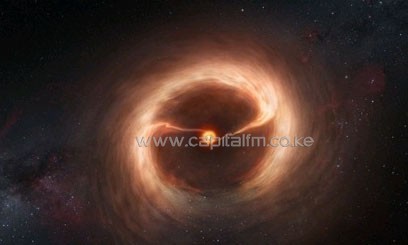
This handout photo released on December 27, 2012 by ESO shows an artist?s impression of the disc of gas and cosmic dust around the young star HD 142527/AFP/ESO
Next week, the guardians who scour the heavens for dangerous space rocks will be closely tracking an asteroid called 99942 Apophis.
Named after the god of evil and darkness in Egyptian mythology, Apophis measures around 270 metres (877 feet) across, a mass able to deliver more energy than 25,000 Hiroshima bombs if it ever smashed into Earth.
Apophis sparked some heart-stopping moments when it was first detected in 2004.
Early calculations suggested a 2.7-percent probability of a collision in 2029, the highest ever seen for an asteroid, but the risk was swiftly downgraded after more observations.
Even so, for April 13, 2036, “there is still a tiny chance of an impact,” says NASA’s fabled Jet Propulsion Laboratory (JPL), which puts the risk at about one in 250,000.
One of the big unknowns is the Yarkovsky effect, a phenomenon discovered by a Russian engineer at the start of the 20th century.
A slowly rotating body that orbits close to the Sun experiences heating on one side of its body that then cools at “night” as it turns over.
This alternate heating and cooling can cause a tiny momentum, depending on the body’s spin and amount of area that warms.
The question is whether, over time, the Yarkovsky effect is accelerating Apophis, thus skewing estimates for future approaches.
Seeking clues, NASA’s deep-space radars at Goldstone, in California’s Mojave desert, and at Arecibo in Puerto Rico will be scanning Apophis, which on January 9 will pass by at some 14.5 million kilometres (nine million miles).
“Using new measurements of the asteroid’s distance and line-of-sight velocity, we hope to reduce the orbital uncertainties and extend the interval over which we can compute the motion into the future,” JPL’s Lance Benner said in an email.
“It’s possible that the new measurements improve the orbit to the point that we can completely rule out an impact.”
On February 15, a 57-metre (185-feet) asteroid, 2012 DA14, will skim the planet at just 34,500 kilometres (21,600 miles). In other words, it will spookily fly by inside the orbit of geostationary satellites.
“It’s going to be the closest predicted flyby of an asteroid,” says Mark Bailey, director of the Armagh Observatory in Northern Ireland.
“Because it is coming so close, even amateur astronomers will be able to watch it as it moves against background stars, and it may be visible through binoculars.”
— Return of the long-distance runner —
Comets — seen by the superstitious as harbingers of great events — could make 2013 a memorable year, astronomers hope.
Lonely travellers of the cosmos, comets comprise giant clumps of primeval ice and dust, formed in the infancy of the Solar System, which loop around the Sun at intervals that can vary from years to aeons.
As they get closer to our star, solar heat warms the comet’s surface, causing it to spew out gases and shed a dusty trail which becomes reflected as a “tail” in the Sun’s rays.
First up is Comet 2011 L4 (PANSTARRS), whose name comes from the telescope at the University of Hawaii which spotted it in 2011.
PANSTARRS could be at its brightest from March 8 to 12, according to US specialist Gary Kronk (http://cometography.com/current_comets.html).
The biggest excitement is being reserved for Comet ISON, named after the International Scientific Optical Network, whose telescope was used by Russian astronomers Vitaly Nevski and Artyom Novichonok to make the find last September.
Right now, it is unclear how bright ISON will be, but by some calculations it could become visible to the naked eye by late November and maybe linger brilliantly for months, becoming a once-a-century event.
ISON is an extraordinary beast, for it last returned to Earth 10 million years ago, or more, says Bailey.
“It’s a ‘new comet’, which comes from a region of the Solar System that’s called the Oort Cloud, an extensive system that extends from around a thousand times the distance of the Earth to the Sun to around 100,000-200,000 times this distance,” Bailey says.
“If you imagine a model of the Solar System whereby the Sun’s a football in the centre of a football pitch and the Earth is on the perimeter, then this comet has come effectively from Australia. That’s the scale of things.”









































